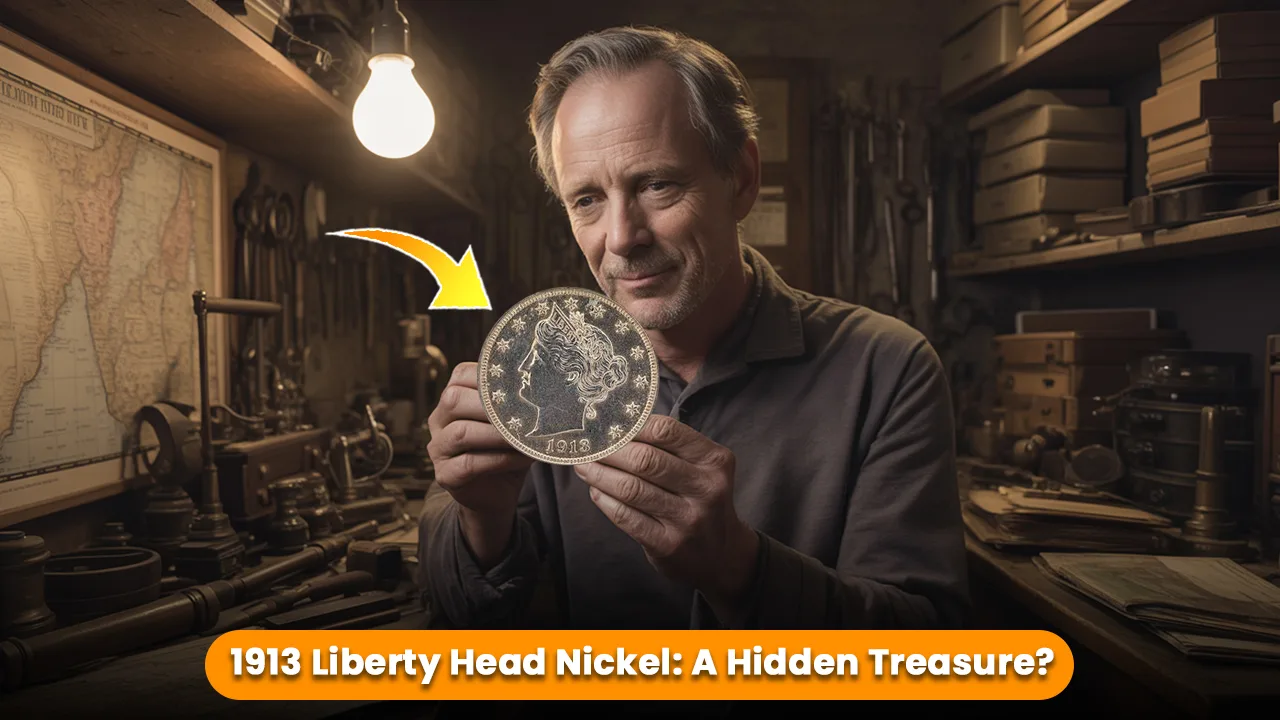Imagine finding a nickel in your pocket change worth more than a million dollars. Sounds like a dream, right? But for some lucky collectors, this dream could be reality with the legendary Buffalo Nickel. Minted between 1913 and 1938, these iconic coins are more than just pocket change—they’re pieces of American history that can fetch jaw-dropping prices.
One ultra-rare Buffalo Nickel sold for $1.4 million, and experts believe others like it might still be hiding in circulation. Could you have one? In this post, we’ll dive into the fascinating world of the Buffalo Nickel, its rich history, why it’s so valuable, and how you can spot a potential treasure in your own collection.
What Is a Buffalo Nickel?
The Buffalo Nickel, also called the Indian Head Nickel, is a five-cent coin minted by the United States from 1913 to 1938. Featuring a Native American chief on the obverse (front) and an American bison on the reverse (back), this coin is a symbol of the American West. Designed by sculptor James Earle Fraser, it’s one of the most iconic coins in U.S. history, blending artistry with cultural significance.
Unlike modern nickels, which are made of a copper-nickel alloy, Buffalo Nickels don’t have precious metal value like silver or gold coins. Yet, their numismatic value—driven by rarity, condition, and historical allure—makes them a favorite among coin collectors. Some are worth just a few cents, while others, like the fabled 1913-S Type 2 or the 1937-D Three-Legged Buffalo, can command prices in the hundreds of thousands or even millions.
Why should you care? Because these coins were circulated widely, and some rare varieties might still be tucked away in old jars, piggy banks, or even your pocket change. Let’s explore why this coin is so special and how you might find a hidden gem.
The History of the Buffalo Nickel
The Design That Captured America’s Spirit
The Buffalo Nickel was born during a time when the U.S. Mint was rethinking its coin designs. In the early 20th century, President Theodore Roosevelt pushed for a “Renaissance of American Coinage” to create coins that reflected the nation’s identity and beauty. Enter James Earle Fraser, a sculptor who crafted a design that resonated with America’s rugged history.
The obverse features a composite portrait of a Native American chief, inspired by three real-life figures: Chief Iron Tail, Chief Big Tree, and Chief Two Moons, all performers in Wild West shows. The reverse showcases an American bison, often mistaken for a buffalo, standing on a mound (in early designs) or a flat plane (in later ones). The design was a bold departure from the more formal Liberty Head Nickel it replaced, capturing the wild spirit of the American frontier.
Why It Was Minted
Introduced in 1913, the Buffalo Nickel replaced the Liberty Head Nickel, which had been in circulation since 1883. The U.S. Mint produced Buffalo Nickels at three facilities: Philadelphia (no mint mark), Denver (D), and San Francisco (S). However, the high-relief design caused problems—dates and details wore down quickly in circulation, and the raised “FIVE CENTS” inscription was prone to wear. In response, the Mint modified the design mid-1913, recessing the denomination to protect it, creating the “Type 1” and “Type 2” varieties for that year.
The coin was minted until 1938, when it was replaced by the Jefferson Nickel. Over its 25-year run, millions of Buffalo Nickels entered circulation, but certain dates, mint marks, and errors make some of them incredibly rare today.
Why Are Buffalo Nickels So Valuable Today?
Rarity and Key Dates
While most Buffalo Nickels are worth a few cents to a few dollars in circulated condition, specific dates and mint marks are highly sought after due to low mintages or historical significance. For example:
- 1913-S Type 2: With only 1.2 million minted, this San Francisco coin is a key date, with uncirculated examples fetching $1,000 or more.
- 1921-S: Only 1.5 million were produced, making it another scarce coin, valued at $1,000+ in uncirculated grades.
- 1926-S: With a mintage of just 970,000, this is one of the rarest regular-issue Buffalo Nickels, worth up to $2,000 in uncirculated condition.
The holy grail? A 1913 Buffalo Nickel struck at the Denver Mint in pristine condition, rumored to have sold for $1.4 million at auction due to its extreme rarity. Only a few Denver-minted 1913 coins are known to exist, making them a numismatic legend.
Minting Errors That Drive Up Value
Minting errors can turn an ordinary Buffalo Nickel into a collector’s dream. Here are some of the most famous:
- 1937-D Three-Legged Buffalo: Caused by over-polishing a die, this error removed the buffalo’s front leg, creating a “three-legged” appearance. Values range from $500 in circulated condition to over $100,000 in uncirculated grades.
- 1916 Doubled Die Obverse: A doubling error on the date and inscriptions can make this coin worth up to $3,000.
- 1918-D 8 Over 7: This overdate error, where a “7” is visible under the “8” in the date, is valued at $1,250 or more.
These errors are rare because they resulted from mistakes during the minting process, and most were caught before entering circulation. However, some slipped through, making them treasures for collectors.
| Key Date Buffalo Nickels | Mintage | Circulated Value | Uncirculated Value |
|---|---|---|---|
| 1913-S Type 2 | 1.2M | $50–$200 | $1,000–$10,000 |
| 1921-S | 1.5M | $75–$300 | $1,000–$5,000 |
| 1926-S | 970,000 | $100–$400 | $2,000–$10,000 |
| 1937-D Three-Legged | Unknown | $500–$2,000 | $50,000–$100,000+ |
How to Spot a Valuable Buffalo Nickel
Ready to check your change? Here’s how to identify a potentially valuable Buffalo Nickel:
Check the Date and Mint Mark
- Date: Look at the year on the obverse (below the Native American’s neck). Key dates like 1913, 1921, or 1926 are a good start.
- Mint Mark: Check the reverse, just below “FIVE CENTS.” A “D” (Denver) or “S” (San Francisco) can indicate rarity, especially for low-mintage years. Philadelphia coins have no mint mark.
Look for Errors
Use a magnifying glass to inspect for errors like:
- The “Three-Legged” buffalo (check the front leg on 1937-D coins).
- Doubling in the date or inscriptions (e.g., 1916 or 1918-D).
- Missing or faint details due to die issues.
Be cautious—counterfeiters sometimes alter coins to mimic errors. For example, some shave off a leg to fake a Three-Legged Buffalo. Always consult a professional for authentication.
Evaluate Condition
Condition is critical in coin collecting. The Sheldon Scale (1–70) grades coins, with 70 being perfect. Key terms:
- Circulated: Shows wear, with faded details (worth less).
- Uncirculated: No wear, looks freshly minted (worth significantly more).
- Proof: Specially struck for collectors, with sharp details (very rare for Buffalo Nickels).
A well-preserved coin, even from a common year, can be worth more than a worn rare date. For example, a 1964 Jefferson Nickel in MS-66 condition can fetch over $100, despite being common, due to its pristine state.
| Coin Grade | Description | Impact on Value |
|---|---|---|
| Poor (PO-1) | Nearly unrecognizable | Minimal value, even for rare dates |
| Good (G-4) | Worn but readable | $10–$100 for common dates |
| Fine (F-12) | Moderate wear, clear details | $50–$500 for key dates |
| Mint State (MS-63+) | No wear, like new | $1,000–$100,000+ for rarities |
Notable Buffalo Nickel Records and Facts
- Record Sale: A 1913 Buffalo Nickel (Denver Mint, pristine condition) reportedly sold for $1.4 million at auction, driven by its rarity and historical significance.
- Three-Legged Legend: The 1937-D Three-Legged Buffalo is one of the most famous error coins in U.S. history, with uncirculated examples selling for up to $104,650 in 2007.
- Cultural Impact: The Buffalo Nickel’s design inspired the modern American Gold Buffalo coin, first minted In 2006, showcasing its lasting legacy.
- Low Mintage: The 1926-S Buffalo Nickel, with only 970,000 minted, is the lowest regular-issue mintage in the series.
- Hidden Gems: Experts estimate a few ultra-rare Buffalo Nickels, like the 1913 Denver-minted variety, could still be in circulation, unnoticed in old collections or change jars.
These facts highlight why Buffalo Nickels are a collector’s dream—part history, part art, and part treasure hunt.
Expert Tips for Coin Collectors
- Start Small: Begin with common Buffalo Nickels in circulated condition to learn the series. They’re affordable (often $1–$10) and widely available.
- Invest in a Magnifying Glass: A 5x–10x loupe helps spot errors and assess condition.
- Buy Graded Coins: Purchase coins certified by PCGS or NGC to ensure authenticity and accurate grading.
- Focus on Key Dates: Target coins like the 1913-S, 1921-S, or 1926-S for investment potential, but only buy the best condition you can afford.
- Beware of Fakes: Altered coins (e.g., shaved legs to mimic the Three-Legged error) are common. Always get rare coins appraised by a professional.
- Join a Community: Connect with local coin clubs or online forums like the American Numismatic Association to learn from experienced collectors.
- Store Properly: Use archival-quality holders or flips to protect your coins from damage.
For appraisals, contact reputable dealers like Littleton Coin Company or Stack’s Bowers. They can assess your coins’ value and authenticity.
Frequently Asked Questions (FAQs)
How can I tell if my Buffalo Nickel is valuable?
Check the date, mint mark, and condition. Key dates like 1913-S, 1921-S, or 1926-S, and errors like the 1937-D Three-Legged Buffalo, are worth the most. Have a professional appraise anything you suspect is rare.
Are all Buffalo Nickels worth a lot?
No, most are worth a few cents to a few dollars in circulated condition. Only specific dates, mint marks, or errors command high prices.
Where can I find Buffalo Nickels?
Check pocket change, old coin jars, or inherited collections. You can also buy them from coin dealers, auctions, or online marketplaces like eBay.
How do I avoid buying fake Buffalo Nickels?
Purchase only from reputable dealers and insist on coins graded by PCGS or NGC. Be wary of deals that seem too good to be true.
Can I clean my Buffalo Nickel to increase its value?
Never clean coins—it can damage them and reduce their value. Collectors prize original surfaces, even if worn.
Conclusion: Start Your Treasure Hunt Today
The Buffalo Nickel isn’t just a coin—it’s a piece of American history that could be worth a fortune. From its stunning design to its rare varieties, this iconic nickel captivates collectors and casual treasure hunters alike. Whether you’re digging through your change jar or starting a serious collection, the thrill of finding a $1.4 million Buffalo Nickel is real. Check those dates, inspect for errors, and consult a professional if you think you’ve struck gold—or, in this case, nickel.
Ready to join the hunt? Share this post with fellow coin enthusiasts, check your piggy bank, or dive into the world of coin collecting. You never know—the next million-dollar nickel could be in your pocket! For more on rare coins and collecting tips, explore resources like the PCGS Coin Price Guide or join a local coin club. Happy hunting!




